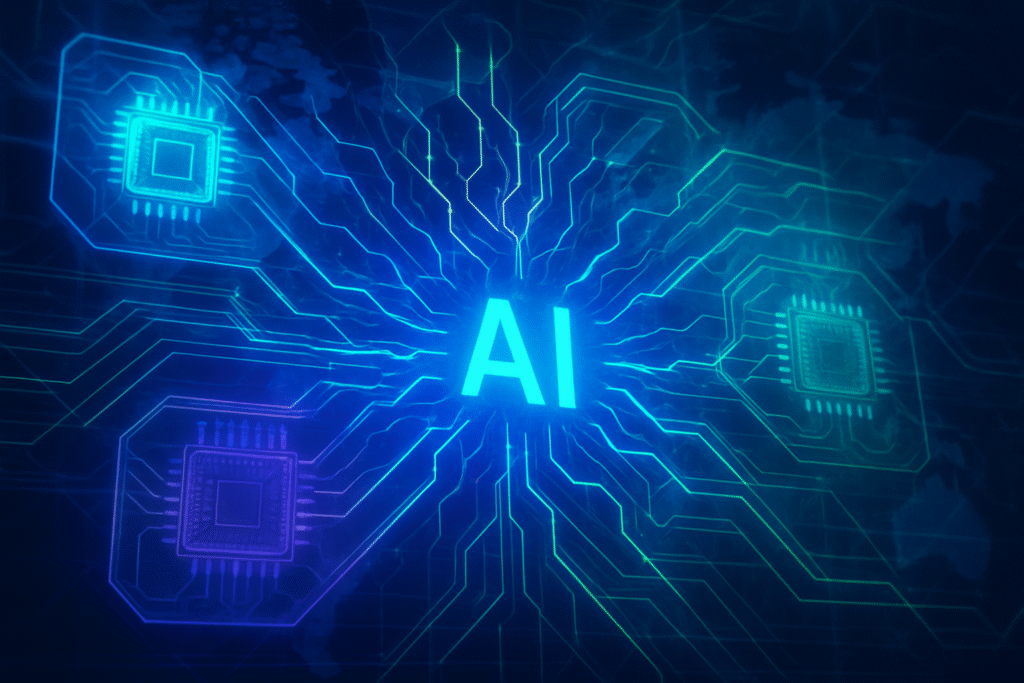
October 6, 2025 – The semiconductor sector is demonstrating unprecedented resilience and robust growth, primarily propelled by the insatiable demand for Artificial Intelligence (AI) and high-performance computing (HPC). This formidable strength persists even as the broader economy, reflected in the S&P 500, navigates uncertainties like an ongoing U.S. government shutdown. The industry, projected to reach nearly $700 billion in global sales this year with an anticipated 11% growth, remains a powerful engine of technological advancement and a significant driver of market performance.
The immediate significance of this resilience is profound. The semiconductor industry, particularly AI-centric companies, is a leading force in driving market momentum. Strategic partnerships, such as OpenAI's recent commitment to massive chip purchases from AMD, underscore the critical role semiconductors play in advancing AI and reshaping the tech landscape, solidifying the sector as the bedrock of modern technological advancement.
The AI Supercycle: Technical Underpinnings of Semiconductor Strength
The semiconductor industry is undergoing a profound transformation, often termed the "AI Supercycle," where AI not only fuels unprecedented demand for advanced chips but also actively participates in their design and manufacturing. This symbiotic relationship is crucial for enhancing resilience, improving efficiency, and accelerating innovation across the entire value chain. AI-driven solutions are dramatically reducing chip design cycles, optimizing circuit layouts, and rigorously enhancing verification and testing to detect design flaws with unprecedented accuracy, with companies like Synopsys reporting a 75% reduction in design timelines.
In fabrication plants, AI and Machine Learning (ML) are game-changers for yield optimization. They enable predictive maintenance to avert costly downtime, facilitate real-time process adjustments for higher precision, and employ advanced defect detection systems. For example, TSMC (NYSE: TSM) has boosted its 3nm production line yields by 20% through AI-driven defect detection. NVIDIA's (NASDAQ: NVDA) NV-Tesseract and NIM technologies further enhance anomaly detection in fabs, minimizing production losses. This AI integration extends to supply chain optimization, achieving over 90% demand forecasting accuracy and reducing inventory holding costs by 15-20% by incorporating global economic indicators and real-time consumer behavior.
The relentless demands of AI workloads necessitate immense computational power, vast memory bandwidth, and ultra-low latency, driving the development of specialized chip architectures far beyond traditional CPUs. Current leading AI chips include NVIDIA's Blackwell Ultra GPU (expected H2 2025) with 288 GB HBM3e and enhanced FP4 inference, and AMD's (NASDAQ: AMD) Instinct MI300 series, featuring the MI325X with 256 GB HBM3E and 6 TB/s bandwidth, offering 6.8x AI training performance over its predecessor. Intel's (NASDAQ: INTC) Gaudi 3 AI Accelerator, fabricated on TSMC's 5nm process, boasts 128 GB HBM2e with 3.7 TB/s bandwidth and 1.8 PFLOPs of FP8 and BF16 compute power, claiming significant performance and power efficiency gains over NVIDIA's H100 on certain models. High-Bandwidth Memory (HBM), including HBM3e and the upcoming HBM4, is critical, with SK hynix sampling 16-Hi HBM3e chips in 2025.
These advancements differ significantly from previous approaches through specialization (purpose-built ASICs, NPUs, and highly optimized GPUs), advanced memory architecture (HBM), fine-grained precision support (INT8, FP8), and sophisticated packaging technologies like chiplets and CoWoS. The active role of AI in design and manufacturing, creating a self-reinforcing cycle, fundamentally shifts the innovation paradigm. The AI research community and industry experts overwhelmingly view AI as an "indispensable tool" and a "game-changer," recognizing an "AI Supercycle" driving unprecedented market growth, with AI chips alone projected to exceed $150 billion in sales in 2025. However, a "precision shortage" of advanced AI chips, particularly in sub-11nm geometries and advanced packaging, persists as a key bottleneck.
Corporate Beneficiaries and Competitive Dynamics
The AI-driven semiconductor resilience is creating clear winners and intensifying competition among tech giants and specialized chipmakers.
NVIDIA (NASDAQ: NVDA) remains the undisputed market leader and primary beneficiary, with its market capitalization soaring past $4.5 trillion. The company commands an estimated 70-80% market share in new AI data center spending, with its GPUs being indispensable for AI model training. NVIDIA's integrated hardware and software ecosystem, particularly its CUDA platform, provides a significant competitive moat. Data center AI revenue is projected to reach $172 billion by 2025, with its AI PC business also experiencing rapid growth.
Advanced Micro Devices (NASDAQ: AMD) is rapidly emerging as NVIDIA's chief competitor. A monumental strategic partnership with OpenAI, announced in October 2025, involves deploying up to 6 gigawatts of AMD Instinct GPUs for next-generation AI infrastructure. This focus on inference workloads and strong partnerships could position AMD to capture 15-20% of the estimated $165 billion AI chip market by 2030, with $3.5 billion in AI accelerator orders for 2025.
Intel (NASDAQ: INTC), while facing challenges in the high-end AI chip market, is pursuing its IDM 2.0 strategy and benefiting from U.S. CHIPS Act funding. Intel aims to deliver full-stack AI solutions and targets the growing edge AI market. A strategic development includes NVIDIA's $5 billion investment in Intel stock, with Intel building NVIDIA-custom x86 CPUs for AI infrastructure. TSMC (NYSE: TSM) is the critical foundational partner, manufacturing chips for NVIDIA, AMD, Apple (NASDAQ: AAPL), Qualcomm (NASDAQ: QCOM), and Broadcom (NASDAQ: AVGO). Its revenue surged over 40% year-over-year in early 2025, with AI applications driving 60% of its Q2 2025 revenue. Samsung Electronics (KRX: 005930) is aggressively expanding its foundry business, positioning itself as a "one-stop shop" for AI chip development by integrating memory, foundry services, and advanced packaging.
Hyperscalers like Google (NASDAQ: GOOGL), Microsoft (NASDAQ: MSFT), and Amazon (NASDAQ: AMZN) are central to the AI boom, with their collective annual investment in AI infrastructure projected to triple to $450 billion by 2027. Microsoft is seeing significant AI monetization, with AI-driven revenue up 175% year-over-year. However, Microsoft has adjusted its internal AI chip roadmap, highlighting challenges in competing with industry leaders. Broadcom (NASDAQ: AVGO) and Marvell Technology (NASDAQ: MRVL) are also key beneficiaries, with AI sales surging for Broadcom, partly due to a $10 billion custom chip order linked to OpenAI. AI is expected to account for 40-50% of revenue for both companies. The competitive landscape is also shaped by the rise of custom silicon, foundry criticality, memory innovation, and the importance of software ecosystems.
Broader Implications and Geopolitical Undercurrents
The AI-driven semiconductor resilience extends far beyond corporate balance sheets, profoundly impacting the broader AI landscape, geopolitical stability, and even environmental considerations. The "AI Supercycle" signifies a fundamental reshaping of the technological landscape, where generative AI, HPC, and edge AI are driving exponential demand for specialized silicon across every sector. The global semiconductor market is projected to reach approximately $800 billion in 2025, on track for a $1 trillion industry by 2030.
The economic impact is significant, with increased profitability for companies with AI exposure and a reshaping of global supply chain strategies. Technologically, AI is accelerating chip design, cutting timelines from months to weeks, and enabling the creation of more efficient and innovative chip designs, including the exploration of neuromorphic and quantum computing. Societally, the pervasive integration of AI-enabled semiconductors is driving innovation across industries, from AI-powered consumer devices to advanced diagnostics in healthcare and autonomous systems.
However, this rapid advancement is not without its concerns. Intense geopolitical competition, particularly between the United States and China, is a major concern. Export controls, trade restrictions, and substantial investments in domestic semiconductor production globally highlight the strategic importance of this sector. The high concentration of advanced chip manufacturing in Taiwan (TSMC) and South Korea (Samsung) creates significant vulnerabilities and strategic chokepoints, making the supply chain susceptible to disruptions and driving "technonationalism." Environmental concerns also loom large, as the production of AI chips is extremely energy and water-intensive, leading to substantial carbon emissions and a projected 3% contribution to total global emissions by 2040 if current trends persist. A severe global talent shortage further threatens sustained progress.
Compared to previous AI milestones, the current "AI Supercycle" represents a distinct phase. Unlike the broad pandemic-era chip shortage, the current constraints are highly concentrated on advanced AI chips and their cutting-edge manufacturing processes. This era elevates semiconductor supply chain resilience from a niche industry concern to an urgent, strategic imperative, directly impacting national security and a nation's capacity for AI leadership, a level of geopolitical tension and investment arguably unprecedented.
The Road Ahead: Future Developments in Silicon and AI
The AI-driven semiconductor market anticipates a sustained "supercycle" of expansion, with significant advancements expected in the near and long term, fundamentally transforming computing paradigms and AI integration.
In the near term (2025-2027), the global AI chip market is projected for significant growth, with sales potentially reaching $700 billion in 2025. Mass production of 2nm chips is scheduled to begin in late 2025, followed by A16 (1.6nm) for data center AI and HPC by late 2026. Demand for HBM, including HBM3E and HBM4, is skyrocketing, with Samsung accelerating its HBM4 development for completion by H2 2025. There's a strong trend towards custom AI chips developed by hyperscalers and enterprises, and Edge AI is gaining significant traction with AI-enabled PCs and mobile devices expanding rapidly.
Longer term (2028-2035 and beyond), the global semiconductor market is projected to reach $1 trillion by 2030, with the AI chip market potentially exceeding $400 billion by 2030. The roadmap includes A14 (1.4nm) for mass production in 2028. Beyond traditional silicon, emerging architectures like neuromorphic computing, photonic computing (expected commercial viability by 2028), and quantum computing are poised to offer exponential leaps in efficiency and speed. TSMC forecasts a proliferation of "physical AI," with 1.3 billion AI robots globally by 2035, necessitating pushing AI capabilities to every edge device. This will be accompanied by an unprecedented expansion of fabrication capacity, with 105 new fabs expected to come online through 2028, and nearshoring efforts maturing between 2027 and 2029.
Potential applications are vast, spanning data centers and cloud computing, edge AI (autonomous vehicles, industrial automation, AR, IoT, AI-enabled PCs/smartphones), healthcare (diagnostics, personalized treatment), manufacturing, energy management, defense, and more powerful generative AI models. However, significant challenges remain, including technical hurdles like heat dissipation, memory bandwidth, and design complexity at nanometer scales. Economic challenges include the astronomical costs of fabs and R&D, supply chain vulnerabilities, and the massive energy consumption of AI. Geopolitical and regulatory challenges, along with a severe talent shortage, also need addressing. Experts predict sustained growth, market dominance by AI chips, pervasive AI impact (transforming 40% of daily work tasks by 2028), and continued innovation in architectures, including "Sovereign AI" initiatives by governments.
A New Era of Silicon Dominance
The AI-driven semiconductor market is navigating a period of intense growth and transformation, exhibiting significant resilience driven by insatiable AI demand. This "AI Supercycle" marks a pivotal moment in AI history, fundamentally reshaping the technological landscape and positioning the semiconductor industry at the core of the digital economy's evolution. The industry's ability to overcome persistent supply chain fragilities, geopolitical pressures, and talent shortages through strategic innovation and diversification will define its long-term impact on AI's trajectory and the global technological landscape.
Key takeaways include the projected growth towards a $1 trillion market by 2030, the targeted scarcity of advanced AI chips, escalating geopolitical tensions driving regionalized manufacturing, and the critical global talent shortage. AI itself has become an indispensable tool for enhancing chip design, manufacturing, and supply chain management, creating a virtuous cycle of innovation. While economic benefits are heavily concentrated among a few leading companies, the long-term impact promises transformative advancements in materials, architectures, and energy-efficient solutions. However, concerns about market overvaluation, ethical AI deployment, and the physical limits of transistor scaling remain pertinent.
In the coming weeks and months, watch for the ramp-up of 2nm and 3nm chip production, expansion of advanced packaging capacity, and the market reception of AI-enabled consumer electronics. Further geopolitical developments and strategic alliances, particularly around securing chip allocations and co-development, will be crucial. Monitor talent development initiatives and how competitors continue to challenge NVIDIA's dominance. Finally, keep an eye on innovations emphasizing energy-efficient chip designs and improved thermal management solutions as the immense power demands of AI continue to grow.
This content is intended for informational purposes only and represents analysis of current AI developments.
TokenRing AI delivers enterprise-grade solutions for multi-agent AI workflow orchestration, AI-powered development tools, and seamless remote collaboration platforms.
For more information, visit https://www.tokenring.ai/.





